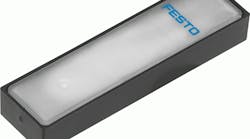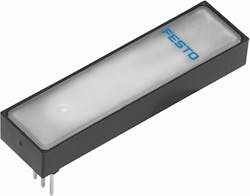The growing trend towards mobile healthcare and equipment for home use means medical devices must get smaller, lighter, and more durable. That has med-tech engineers looking to piezoelectric valves for pneumatic applications. Piezo valves offer advantages over solenoid valves such as smaller size, higher efficiency, and quieter operation, and they are well-suited for controlling flow and regulating vacuum and pressure.
Piezoceramics have the unique property of deforming proportionally to an electrical charge and remaining deformed until the charge is removed. This permits precise mechanical movement while consuming little power. The materials are already used in ink-jet printers, precision motors, and automotive applications, just to name a few.
At the heart of a piezoelectric valve is a beam-like actuator that’s fixed at one end and has a seal covering a port at the other end. The beam consists of a layer of piezoceramic material bonded to a passive, conductive substrate, such as carbon fiber. Applying an electrical charge causes the piezo layer to contract and the valve actuator to bend, opening the valve port.
Actuator movement is proportional to charge. A small charge opens the valve slightly; higher voltage opens the valve more, making for a proportional valve that can remain in any position using little or no energy.
Benefits
Unlike the coil/core assemblies in solenoid valves, piezo valves have no sliding parts, and the moving elements have much lower inertia. Thus, the valves react quickly and stand up to external loads and shocks. Their dynamic nature, combined with techniques such as closed-loop feedback, permits precise control over pneumatic functions.
The construction of piezoelectric valves makes them quieter than solenoid valves, and electronic control of open and close rates allows nearly silent operation. Thus, they’re especially suited for medical devices designed for night-time use without adding bulky and costly sound insulation.
They also require a fraction of the power of a conventional solenoid. Piezo valves, by their nature, consume up to 95% less energy than comparable solenoid valves. Their capacitive operating properties let them maintain an active operating state without consuming power. In mobile devices, high energy efficiency equates to long battery life, less-frequent charging, and greater independence for the user. It also means little or no heat buildup, eliminating the need for cooling, permitting more-compact designs and potentially offering greater reliability.
Commercial valves
Several pneumatic-component manufacturers offer piezo valves. For instance, Festo Corp., Hauppauge, N.Y., manufactures a variety of piezo-based pneumatic valves and valve manifolds.
One version, its VEMR 2/2-way valve, measures 1.7 × 0.4 × 0.5 in. and is rated for 17 lpm flow at 30 psi and inlet operating pressures from 10 to 50 psig. Response time is <10 msec, leakage is <0.6 l/hr, and it is compatible with air, oxygen, and inert gases. The valve is suited for flow control, but combining it with a flow sensor makes it a proportional flow-control valve.
The company’s VEMC 3/3-way valve has rated flow of 11.0 lpm (at 14 psi) on the connection side and 9.5 lpm (at 14 psi) on the exhaust side. It’s designed for pressure regulation, and adding a pressure sensor makes it a proportional pressure regulator.
Where they’re used
Piezo valves are suited for such applications as portable breathing equipment for treating chronic respiratory diseases and sleep apnea; anti-bedsore mattresses for immobile patients; and devices for lymph drainage and limb compression.
Festo’s VEMx valves are used on a variety of medical devices. For example, one OEM redesigned its oxygen conservers to take advantage of piezo valves’ low power requirements. (Conservers are used with portable oxygen cylinders to only deliver flow when a patient inhales, so the oxygen supply lasts longer than with continuous flow.) Previous versions typically needed battery changes every few weeks. Now the units can run for more than two years on a single set of AA batteries.
Other home-equipment manufacturers are using piezoelectric valves for proportional oxygen delivery in the latest generation of portable oxygen concentrators. They’re taking advantage of both low power consumption and dynamic proportional control to improve the oxygen therapy capabilities of portable equipment.
And a leading biotechnology firm uses piezo valves to fit eight proportional regulators onto a single manifold. It automates a process requiring precise control of vacuum and low pressure to measure individual microscopic cells. The entire manifold – contained in a 20-mm-high package with the footprint of a DVD – communicates via a built-in serial port. Advantages include low heat generation, better performance, and a 90% reduction in size over previous designs.
Although they boast many advantages over solenoid valves, piezoelectric valves have their limitations. For starters, they cost more than basic on/off solenoid valves, though prices for piezo valves are coming down. Solenoids can also handle a much wider range of pressures and flows. In general, today’s piezo valves can directly control pressures from vacuum to about 45 psi and flows from 0 to 25 lpm. Nonetheless, this performance is within the range of pressure and flow needed in many portable pneumatic applications — and that range is getting broader as more piezoelectric products are released to market.
Click here to download a PDF from festo about their piezo valves.



